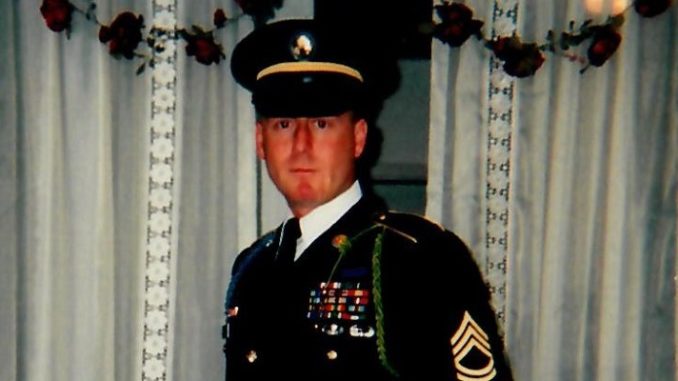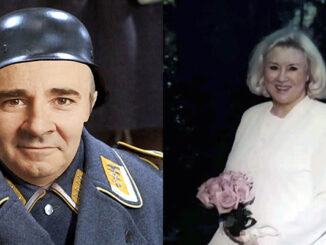
Believe it or not, as an active duty member of the United States military, you could be imprisoned for the rest of your life because military leaders are attempting to ingratiate themselves with Congress by being as politically correct as possible.
When you decide to serve your country in the military, the danger is not from a foreign adversary, but rather unethical admirals and generals who crave having another star on their collar.
Some of our readers probably remember the alleged “canal killings” in 2009. The United States Army effectively created a depiction of First Sergeant (1SG) John E. Hatley as a cold-blooded killer who executed four Iraqis. Because of it, 1SG Hatley has been in prison for ten long years. The Army told Hatley he could probably receive parole if he would only admit guilt and express remorse.
But Hatley won’t admit guilt because he is innocent of the crimes they accused him of committing. MilitaryCorruption.com has been given documentation that certainly casts doubt on how his trial was conducted. There were no bodies found, no names of victims or their families, no physical or forensic evidence.
A seven-man dive team searched the canal where the bodies were supposedly dumped found nothing. No bullets or casings were found in the area, which is in itself weird because this had been the site of intensive fighting.
THE CID GETS INVOLVED

Criminal Investigation Division (CID) was taken to the house where the insurgents were taken into custody, and the people there said no one was missing or dead in their families.
Their names were not obtained. Neighbors in the area were also questioned and they too said no one was missing or dead. The farmer who owned the land of the supposed killings said he knew of no one being killed. Some soldiers said there were four prisoners; some said there were five.
No one knew what happened to the fifth man. Testimony was inconsistent and contradictory. Charges were not filed until ten months after the event when a sergeant was up on charges for two instances of striking an NCO, and one count of threatening an officer with great bodily harm.
He offered CID info on a homicide if they would grant him immunity. Immunity was not granted, but his attorney had already given CID the file. All men in the patrol were interrogated intensely with some being threatened with life in prison. All of them but John Hatley took plea deals rather than risk “life in prison.” The threats were probably similar to what Lieutenant General Michael Flynn was subjected to by the FBI in the whole Russian collusion caper.
John E. Hatley was convicted by the United States Army solely on the basis of coerced testimony. One witness said when he shot a man in the back of the head, he fell back against his leg. That’s highly unlikely if not impossible, because when people are shot, their body normally goes in the direction of the bullet.
President Kennedy’s head violently lurched back and to the left, meaning the bullet was from his front and the right, but the government wants us all to believe he was shot in the back from the Book Depository. It’s a law of physics. Normally, the object struck by a bullet moves in the direction of the bullet.
Again, there were no bodies, no names, no physical or forensic evidence—only the testimony of men with something to gain. If they testified as they were told by Army lawyers, they would receive a much better deal.
Oh and hey… Army brass had something to gain also. By convicting someone (anyone) for murdering innocent civilians, they could help to make amends for other Army wartime atrocities. Anyone remember Abu Ghraib military prison where people were being subjected to torture and humiliation for the entertainment of Army troops?
This is just another case of someone railroaded right into a military penitentiary, not based on any evidence, but based on being politically correct and alleviating an ocean of guilt about being caught in the act.
We found out a long time ago, the military doesn’t need evidence to convict someone. In the civilian world a district attorney can indict a ham sandwich. Because of the closed military structure, that same “ham sandwich” is not only indicted but convicted as well. It’s heinously disgraceful how our military can manipulate their judicial system to protect the organization itself, and senior military officers from any scrutiny or accountability.
EXCELLENT ARTICLE ON THE JOHN E. HATLEY CASE
Authored by: Keri Ross Thoele
Published by: Criminal Justice Law International

John E. Hatley is a highly-decorated 20-year combat veteran and Army Ranger, who is now incarcerated in the United States Disciplinary Barracks (USDB) at Ft. Leavenworth for the premeditated murder of four men of Middle Eastern descent. If it seems like an open and shut case, it is anything but.
In April 2009, Hatley was sentenced to life, with the possibility of parole.
His sentence was subsequently reduced to 40 years and then, to 25 years. On April 16, 2019, Hatley has thus far served a full ten years incarcerated in the USDB (U.S. Detention Barracks) at Fort Leavenworth, Kansas. There is just one problem: there were no murders.
Hatley has maintained his innocence since the beginning and has refused to waiver and compromise his honor. Hatley’s plight began during a climate of “punishing US soldiers” (e.g. the “Leavenworth 10”) as a reaction to political opposition to the American presence in the Middle East and the accusations of inhumane treatment of detainees in Guantanamo Bay at the hands of the US Army.
In the wake of the backlash, the Army upper echelon engaged in an effort to “prove” that they held US soldiers to high standards of engagement and accountability for their actions.
Unfortunately, this effort culminated in a witch-hunt like frenzy that ultimately led to a myriad of questionable court-martials of soldiers who were simply carrying out their duties in combat situations and were not guilty of any wrongdoing.
It also led to a climate of fear and finger-pointing within the ranks. Coupled with the anomaly of the military’s incredibly high conviction rate in spite of a lack of evidence, this created fertile ground for the convictions of innocent soldiers.
IN ORDER TO CONVICT AN INNOCENT MAN,
YOU MUST FIRST PAINT HIM AS A COLD-BLOODED KILLER

Further, in this same climate, some mainstream media painted American soldiers as cold-blooded killers.
Hatley was not only severely defamed by the media in general, but a well-known magazine featured an article about his case that fed the American public outright lies. Hatley wrote a detailed rebuttal, but it was not published by the magazine nor were the false statements retracted.
Thus, if one is attempting to find factual information about the case, it has become impossible to sort through the misinformation without access to the record of trial, supporting documents, and direct interviews with the witnesses, including Hatley himself. Every detail put forth in this article is supported by all of these.
Hatley was convicted solely on the accusation of a soldier, Jesse Cunningham, whom he was in the process of bringing charges against, and the coerced and coached testimony of a handful of his men who were threatened with life in prison and never seeing their families again, and who were each being told the others were pointing the finger at them.
With a court martial-conviction rate of almost 98%, these few accused soldiers – with the exception of Hatley – were not willing to take the chance to fight for the truth.
Sometime during March or April of 2007, a firefight occurred between First Sergeant Hatley’s unit and a group of Iraqi fighters.
Hatley and his men chased the insurgents to a house about four blocks away from the initial firefight. The house was occupied by women and children who said they were the men’s wives and children. The men were taken into custody and a large cache of weapons and ammunition was recovered.
However, as per the stringent policies pertaining to detaining enemy combatants, there was not enough evidence to detain the insurgents. This was a routine scenario for American soldiers, and First Sergeant Hatley made the decision to take the five detained prisoners to the outskirts of their sector and release them, which, according to Hatley, they did without incident.

Lady Justice is most often depicted with a set of scales typically suspended from one hand, upon which she measures the strengths of a case’s support and opposition. The scales represent the weighing of evidence, and the scales lack a foundation in order to signify that evidence should stand on its own.
THE BLINDFOLD:
Since the 16th century, Lady Justice has often been depicted wearing a blindfold. The blindfold represents impartiality, the ideal that justice should be applied without regard to wealth, power, or other status.
THE SWORD:
The sword represented authority in ancient times, and conveys the idea that justice can be swift and final.
THE TOGA:
The Greco-Roman garment symbolizes the status of the philosophical attitude that embodies justice.
THE ARMY FIGURES OUT A WAY TO CONVICT AN INNOCENT MAN,
IN ORDER TO PLEASE TASKMASTERS AND EASE A GUILTY CONSCIENCE
Ten months after this event, Cunningham was facing two charges of striking a fellow NCO and one charge of threatening an officer with great bodily harm. Cunningham asked his attorney to take an offer of a deal to the Criminal Investigation Division (CID) of the Army offering information on a homicide in exchange for immunity. Immunity was denied, but the attorney had already given CID Cunningham’s statement.
At this point, Cunningham did not cooperate with CID, but they decided to proceed with the investigation by bringing in a different soldier in the unit they had determined to be
easily manipulated. This soldier wore a wire for three to four weeks in an attempt to gather incriminating information; however, no incriminating information was obtained. It stands to reason that CID would have coached this man on how to engage others in a particular discussion, yet they got nothing.
Next, CID brought all of the men in the unit in for questioning. Those who had been part of the patrol were interrogated for days using offers of reduced sentences or immunity and threats of life in prison (including the effects on their families). They were told others had incriminated them.
Eventually, all of the men except Hatley made pretrial agreements to plead guilty.
This is understandable considering the Army has a conviction rate of nearly 98% and the full weight of the US government behind them. Hatley was offered the same deal if he would roll over on his superior, but Hatley would neither plead guilty to something he didn’t do or falsely implicate someone else.
There was not a single shred of physical or forensic evidence against Hatley or his co-accused, Sergeant First Class Joseph P. Mayo and Sergeant Michael Leahy. A seven-man Army diving team searched the canal where Cunningham said four men were executed and the bodies were supposedly dumped. They found nothing.
According to CID, no bodies, no items of clothing, no personal belongings, no bone fragments, no bullets, or no casings were found. CID had one of the soldiers take them to the house where the five enemy fighters had been apprehended to interview the family members of the supposed victims.
WITNESSES SAY THERE WERE NO KILLINGS

All of them said they knew of no one missing or dead. No names were obtained. Further, CID interviewed neighbors from the surrounding areas who said no one was missing from the neighborhood.
Also, CID interviewed the farmer on whose land the canal is located where the alleged bodies were dumped. The farmer said he had zero knowledge of any bodies being dumped or anyone being murdered in that area. None of this was disputed, and, remarkably, the case went to trial with no victims being identified.
According to Hatley and several others on the patrol that day, five men – not four – were taken into custodyand released. The prosecutors were aware that “witnesses” could not agree on how many people were allegedly executed, but this did not deter them in seeking a conviction.
At his trial, Hatley told his lawyer that five men were taken into custody, and his lawyer told him not to bring it up or they might just charge him with another murder.
The testimonies at trial included several key points of contradiction when it came to the alleged execution, including how many men were captured and supposedly shot, who
fired shots and in what order, how many shots were fired, and where shots were placed.
Further, testimony was accepted by one man who was known to have previously given a false statement to the CID, and some of the testimony contradicted the laws of physics. This is important because Hatley was convicted solely on testimony, and that testimony was contradictory and inconsistent.
Hatley, unaware at the time of the tactics used in a military court-martial, trusted his counsel implicitly.
He said to his lawyer, “I’m putting my faith in you because this is your area of expertise. If we were in downtown Baghdad, I’d expect you to shut up and do as you’re told because that’s my area of expertise. That’s why I plan on keeping my mouth shut and trusting you to get me through this.”
SACRIFICED TO FURTHER A HIDDEN AGENDA

His lawyers advised him not to testify on his own behalf. Further, they did not send independent investigators to the crime scene, which seemed unnecessary at the time because CID found no physical or forensic evidence and was unable to identify any victims.
In hindsight, Hatley would learn that the military he had served without question for the past nineteen and a half years had no qualms about sacrificing him to further their own agenda. He would also learn that when accused by the military, he was, in essence, guilty until proven innocent, and neither he nor his legal counsel understood up front that the burden of proof was slanted against him.
The Uniform Code of Military Justice (UCMJ) is a broken and corrupt system that has imprisoned more than one innocent man. It is nothing like a civilian court. Little to no evidence is needed for a conviction. Hatley, and other American soldiers in similar situations, have no recourse for a retrial in a civil court in spite of their status as American citizens.
Further, the Deputy Assistant to the Army, Francine Blackmon, vetoed the parole board who had initially granted Hatley’s parole in 2017. Guilt or innocence aside, Hatley has been a model prisoner since his incarceration.
As evidenced in his parole packet, he has not only maintained his high standards of conduct and leadership, he has positively influenced the behavior of others within his pod and has been instrumental in changing the culture of it so that very few problems occur.
Hatley has saved a life while incarcerated and has never been sent to isolation for disciplinary purposes.
Further, he has been determined to be zero risk for recidivism and his parole packet included evidence of multiple job offers and strong family and community support for acclimating back into society. These are the requirements relevant to his request for parole.
PAROLE BOARD VOTED TO GRANT PAROLE, BUT FRANCINE VETOED THEIR DECISION

In 2017, the Parole Board after thoroughly reviewing his packet and listening to the testimony of those who spoke on his behalf, including United States Congressman Bill Flores, agreed and voted to grant him parole.
However, Francine Blackmon vetoed their decision citing the “heinous nature of the crime” as her reason for doing so. However, Blackmon was inconsistent with her own previous decisions and, therefore, had some other underlying motive for her actions.
In 2015, Blackmon had approved the parole of the co-accused soldiers, Leahy and Mayo, who had been convicted with the same culpability as Hatley.
Blackmon, in those two cases, supported the decision of the Board to grant parole and did not reverse based on “the heinous nature of the crime,” but yet those two men served even less time in prison than Hatley.
She set the precedent by granting their parole the very first time they came up for review. Even on the premise that a crime was committed, how was the crime less heinous for these two soldiers than for Hatley?
In 2018, the same board that granted Hatley parole the first time denied it on the basis that he is not taking responsibility for his actions. Doing so, they have, in essence, denied his right to maintain his innocence.
Hatley, a 50-year-old native Texan, with a longstanding combat and military career as a Paratrooper, Ranger, and Infantryman, has an impeccable record both in the military and the USDB – both before and after the supposed crime. His character has not changed; he is still the same highly-decorated non-commissioned officer who received numerous accolades for his honor, sacrifice and valor, including
- Two Bronze Stars
- Army Commendation Medal for Valor
- Ranger Tab, and
- Induction into the Audie Murphy Club
This latter award is noteworthy because the Audie Murphy Club is an exclusive honor reserved for men who demonstrate a myriad of leadership and character traits.
Hatley has stated that nothing means more to him than his name and his honor and that he will sit in the USDB for the entirety of his sentence rather than confess to a crime he did not commit.
In this regard, the Unified Code of Military Justice, the United States Army, and the United States as a whole have failed to protect the Constitutional rights and liberty of a soldier who has put his very life on the line to protect those same rights and liberties for all other US citizens.
For a much more in-depth view into the travesty of justice concerning John E. Hatley a new website is being constructed: http://freejohnehatley.com
While the website is not yet available, a Facebook page is active at: https://www.facebook.com/JohnEHatley/
A SPECIAL NOTE TO JOHN HATLEY: We at MilitaryCorruption.com are watching your case very closely. It’s painfully obvious you were railroaded into prison by a government seeking to make amends for their sins such as the 2003 Abu Ghraib prison scandal which gave the Army and America a big black-eye.
And for fifty points, what happened to the woman in command of Abu Ghraib military prison? Her title and name was Army Brigadier General Janis Karpinski. Following the retirement playbook, she denied knowing anything about any torture or prisoner degradation. Janis “I know nothing” Karpinski was ultimately allowed to quietly retire to avoid any accountability.
So, John Hatley… we want you to know there are many people who are rooting for you and hope that President Trump hears the calls for military judicial reform… he did a great job for civilian prison reform, it’s now time to take action to correct military deficiencies.
Stay strong John Hatley! We will continue to expose the military corruption in your case, until some person in our government with a sense of fairness and justice realizes what a terrible transgression has occurred to you. Here’s the title for a book you should write… “Sent to Prison to Relieve America’s Guilty Conscience”



